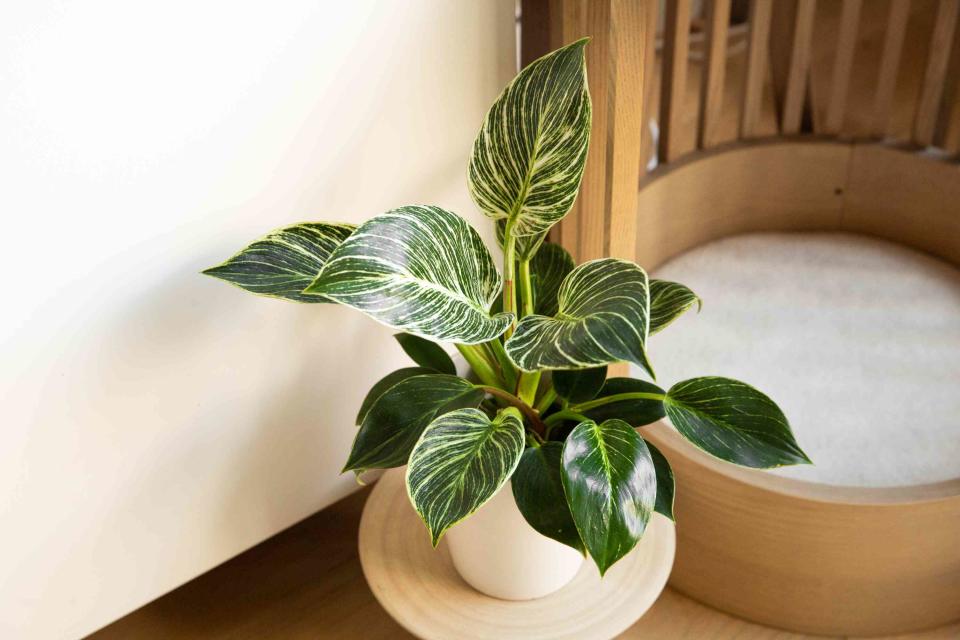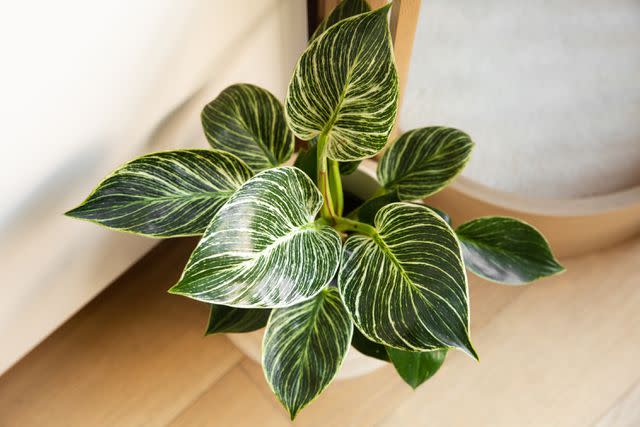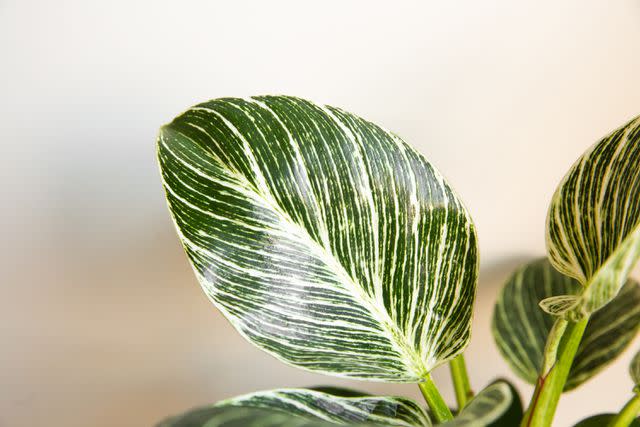How to Grow and Care for Philodendron Birkin
No two plants are alike of this philodendron with variegated foliage

The Spruce / Phoebe Cheong
Reviewed by Barbara Gillette
Philodendron Birkin is a sought-after variety of philodendron that is believed to be either a rare mutation of philodendron 'Rojo Congo' or a hybrid of two philodendron cultivars, ‘Congo’ and ‘Imperial Green’. It stands out because of the unique creamy white or yellow streaks on the green leaves. It has a thick, upright, self-supporting stem, promoting a more tree-like appearance. Slow-growing and compact, it's a great plant for small spaces. However, if you bring this plant home, you need to be patient—the variegation only appears on mature plants, and sometimes it might produce leaves with a reddish tone or part red, part creamy white stripes.
Like all philodendrons, it is toxic to humans and pets.
Common Name | Philodendron Birkin, white wave, Birkin white wave |
Botanical Name | Philodendron 'Birkin' |
Family | Araceae |
Plant Type | Perennial |
Mature Size | 3 ft. tall, 3 ft. wide |
Sun Exposure | Partial |
Soil Type | Well-drained |
Soil pH | Acidic, neutral |
Hardiness Zones | 9-11 (USDA) |
Native Area | Central America |
Toxicity | Toxic to humans and pets |
Philodendron Birkin Care
Here are the main care requirements for growing a philodendron Birkin:
Place it in a location with bright, indirect light.
Use a potting mix for aroids or make our own.
Water only when the top layer of soil has dried out.
Keep the room temperatures between 65 and 85 degrees F and the humidity between 50 and 60%.
Fertilize every two months during the spring and summer.

The Spruce / Phoebe Cheong

The Spruce / Phoebe Cheong
Light
Most philodendron species appreciate filtered light, and the Birkin is no exception. A west- or east-facing window with medium bright, indirect light usually works well. To maximize the variegation, you don't want a corner that is too shady, but too much direct sun can scorch the leaves and result in limp, leggy growth. This plant usually appreciates a few hours of light morning sun.
Because philodendron Birkin likes to grow toward sunlight, rotating the plant periodically helps promote even growth.
Soil
Philodendrons thrive in potting mixes specially designed for aroid species. To make your own, blend one part potting soil, one part orchid bark, and one part perlite, which provides the right amount of acidity, moisture retention, drainage, and aeration.
Water
They might be hard-to-kill plants, but philodendron Birkin isn't impervious to overwatering. one of the biggest problems with this plant. Soggy soil frequently leads to mushy stems and root rot. Watering thoroughly and allowing the top few inches of soil to dry out before topping up the moisture level works best.
While you don't want the plant to completely dry out, don't panic if you forget to water it occasionally. They're pretty forgiving and usually perk up after a thorough watering. Be sure to drain away any excess water.
Temperature and Humidity
These tropical beauties thrive in warmth and humidity, with ideal temperatures ranging from 65 to 85 degrees F and never dropping below 55 degrees F. They are great houseplants for bathrooms.
The humidity level should be between 50 and 60%. If the air in your home is dry, use a humidifier or place a pebble tray filled with water underneath your plant.
Fertilizer
Regular fertilization isn't always essential for philodendron Birkin, and too much feeding causes root burn and yellowing leaves. However, feeding with a balanced, weak solution of houseplant fertilizer every couple of months during the growing season in the spring and summer promotes faster growth, improved variegation, and glossy foliage.
The 15 Best Places to Buy Plants Online in 2023
Pruning
This slow-growing plant doesn't have any demanding pruning requirements. Just remove any leaves that are damaged or past their best, so all the energy is directed to the healthy foliage.
Propagating Philodendron Birkin
Like most philodendrons, the Birkin is easily propagated from stem cuttings.
Use sharp, sterile scissors or pruning shears to take a 4- to 5-inch stem cutting with four to six leaves.
Remove the bottom leaves to expose the nodes and leave two or three leaves at the top of the cutting.
Submerge the nodes in water and position your cutting in a spot with bright, indirect light.
Change the water every few days.
Once you see small white roots sprouting that are around 1 inch in length, the cutting is ready to be moved to soil. Usually, this takes around two to four weeks.
When planting in soil, select a moist, well-draining mix and continue to position the cutting in the same spot where it receives bright, indirect light.
Keep the soil consistently moist but not waterlogged for the first few weeks.
Potting and Repotting Philodendron Birkin
This slow-growing philodendron only needs repotting only when the roots grow out of the drainage holes. This is also an opportunity to refresh the potting mix.
Don't be tempted to go too large with the new pot—it's more likely that excess moisture will gather, often leading to root rot. A couple of inches larger in pot diameter is usually plenty.
Add a fresh batch of aroid potting mix (aroid is the common name for plants in the Aracaea family, which includes many houseplants) until the pot is around a third full. Once the plant is in, fill
in any gaps around it until the mix reaches just below the pot's rim, after gently patting the soil down. After watering, return the plant to its original spot.
Common Problems With Philodendron Birkin
Just because philodendron Birkin has a reputation for being pretty easy-going, it doesn't mean it's immune to problems. To keep the foliage looking its best, it still needs the right light, water, and humidity levels. Look out for the following issues, which are often signs that you need to change something.
Leaves Turning Yellow
It's not unusual to see older leaves at the base of the plant yellow and drop, making way for newer, healthier growth above it. However, if you're seeing unattractive yellowing leaves on new growth or in large quantities, it's most likely a sign of overwatering or overfertilization.
Brown Tips
When the edges or tips of your plant's foliage start to turn brown, it's likely because you need to up your watering schedule or provide higher humidity levels. If you have a lot of tropical plants, consider investing in a humidity meter. If levels are below 50%, use a humidifier, mist your plant, and set it on a tray filled with pebbles and water. Keep it away from heating vents and consider a spot like a bathroom with higher humidity levels.
Browning leaves might also signal that your plant is in a spot where it's receiving too much direct intense sunlight.
Curling Leaves
If the leaves are beginning to curl, it might be an early sign that it isn't getting enough moisture. If the top few inches of soil are dry, it's time to water.
Also, avoid overfeeding your plant. Too much fertilizer results in curling and browning leaves.
Dropping Leaves
These tropical plants like to be kept consistently warm and away from draughts. A sign that your Birkin needs a warmer spot is regularly dropping leaves.
Frequently Asked Questions
Does philodendron Birkin climb?
While it does not have a climbing habit, a support pole might be helpful for top-heavy specimens.
Is philodendron Birkin rare?
It is not always easy to source these plants due to the growing demand and limited availability as well as their unstable variegation.
Why is the variegation fading on my philodendron Birkin?
Some seasonal fading is natural, but insufficient light may result in your plant losing those striking creamy white pinstripes. Bright but indirect light is needed to promote good variegation. Due to the unstable nature of this mutation, there is also a possibility that it could revert to a Rojo Congo, with the variegation disappearing permanently.
Read the original article on The Spruce.

